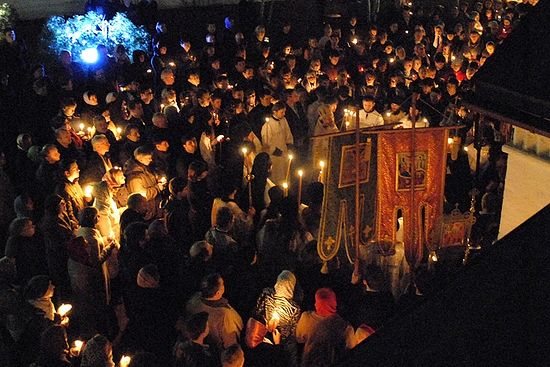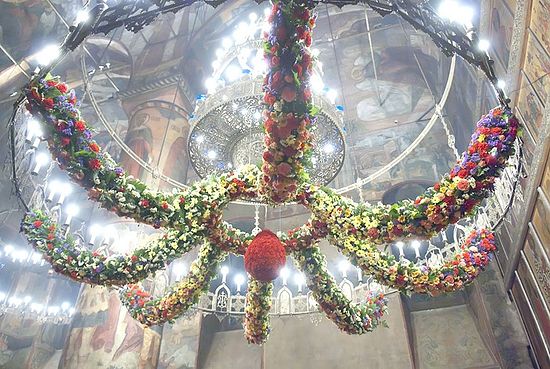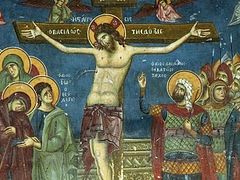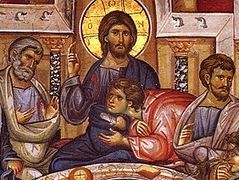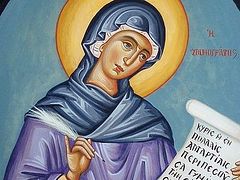The services of Pascha mark the end of Christ’s Passion and the beginning of new life in the resurrection of the risen Lord. All come and partake of this joy.
Along with audio recordings of Paschal hymns sung by the Sretensky Monastery Choir, we present an outline of the services of the Bright Resurrection of Christ.
On Saturday evening, the Acts of the Apostles is read in the church. This Scripture contains the irrefutable witness of Christ’s Resurrection. Afterwards begins the Midnight Office, also called Nocturns, with the canon of Holy Saturday. After the ninth ode, at the singing of the irmos (at the katavasia), Weep not for me, O Mother, the clergy cense around the Holy Epitaphion (Burial Shroud), and then the priest lifts it upon his head and bears it (with Christ’s head facing east) into the altar through the royal doors, which are then closed. The Holy Epitaphion is placed on the altar table and remains there until the leave-taking of Pascha, just before the Ascension, in remembrance that Christ the Savior was on the Earth for forty days after His Resurrection.
From apostolic times, the Church has always celebrated the Paschal services at night. As in ancient Israel, who kept vigil during the night that they were delivered from Egyptian slavery, so also the new Israel—the Christian Church—keeps vigil on the “sacred and saving night” of the Bright Resurrection of Christ, the harbinger of the light-bearing day of spiritual renewal and deliverance from slavery to sin and the devil.
The beginning of the Paschal Matins is preceded by a solemn Cross procession around the church (while singing the stichera, Thy resurrection, O Christ our Savior , in order to meet Christ outside of it, like the myrrh-bearing women who met the risen Lord outside Jerusalem:
Thy resurrection, O Christ our Savior, the angels in heaven sing, enable us on Earth, to glorify Thee with purity of heart.
In the narthex (anteroom) of the church (this may also take place outside the main doors of the church), before the closed doors, the Pascal Matins are begun with the proclamation, Glory to Thy holy, and consubstantial, and life-creating Trinity, always, now and ever, and to the ages of ages, and the singing of Pascal troparion with verses, according to the Pascal order of services:
Clergy: Christ is risen from the dead, trampling down death by death, and upon those in the tombs bestowing life! (Thrice)
Choir: Christ is risen from the dead, trampling down death by death, and on those in the tombs bestowing life! (Thrice)
Stichos 1: Let God arise and let His enemies be scattered, and let them that hate Him flee from before His face.
Choir: Christ is risen from the dead, trampling down death by death, and upon those in the tombs bestowing life.
Stichos 2: As smoke vanisheth, so let them vanish, as wax melteth before the fire.
Choir: Repeat Troparion
Stichos 3: So let the sinners perish at the presence of God, and let the righteous be glad.
Choir: Repeat Troparion
Stichos 4: This is the day which the Lord hath made; let us rejoice and be glad therein.
Choir: Repeat Troparion
Priest: Glory to the Father and to the Son and to the Holy Spirit.
Choir: Repeat Troparion
Priest: Both now and ever, and unto the ages of ages. Amen.
Choir: Repeat Troparion
Priest: Christ is risen from the dead, trampling down death by death.
Choir: And upon those in the tombs bestowing life.
After the singing of the words, Glory to the Father, and to the Son, and to the Holy Spirit, the second half of the Pascal troparion (and upon those in the tombs bestowing life), the doors are opened, and the clergy and faithful enter the church.
After the Great Ectenia, the Pascal Canon is sung, which is attributed to St. John Damascene (eighth century).
The first words of the irmos of each ode is sung in the altar, and the choir then repeats it. Each ode ends with a repeat of the irmos and the troparion sung thrice: Christ is risen…
At every ode of the canon, the priest censes the entire church. Censing the people, the priest greets them with the words, “Christ is Risen!” The faithful reply, “In truth He is Risen!” and looking toward the cross in the priest’s hand, cross themselves.
After each ode there is a small ectenia.
After the third ode the hypakoe is sung:
Forestalling the dawn, the women came with Mary, and found the stone rolled away from the tomb, and heard from the angel: Why seek ye among the dead, as though He were mortal, Him Who liveth in everlasting light? Behold the grave-clothes. Go quickly and proclaim to the world that the Lord is risen and hath slain death. For He is the Son of God Who saveth mankind.
After the sixth ode, the kontakon is sung, and the ikos, then, Having beheld the resurrection of Christ (thrice) and Jesus having risen from the grave (thrice).
Kontakion, Tone 8:
When Thou didst descend into the tomb, O Immortal One, Thou didst destroy the power of hell. And didst rise again as conqueror, O Christ God, saying to the myrrh-bearing women “Rejoice!”; granting peace to Thine apostles, and bestowing on the fallen, resurrection.
Ikos:
The myrrh-bearing women forestalled the dawn, seeking, as it were day, the Sun that was before the sun and Who had once set in the tomb, and they cried out one to another: O friends! come, let us anoint with spices the life-bringing and buried Body, the Flesh that raised up fallen Adam, that now lieth in the tomb. Let us go, let us hasten, like the Magi, and let us worship and offer myrrh as a gift to Him Who is wrapped now not in swaddling clothes but in a shroud. And let us weep and cry aloud: O Master, arise, Thou Who dost grant to the fallen, resurrection.
Hymn of the Resurrection:
Having beheld the Resurrection of Christ, let us worship the holy Lord Jesus, the only sinless One. We worship Thy Cross, O Christ, and Thy holy Resurrection we hymn and glorify. For Thou art our God, and we know none other beside Thee; we call upon Thy name. O come, all ye faithful, let us worship Christ’s holy Resurrection, for, behold, through the Cross joy hath come to all the world. Ever blessing the Lord, we hymn His Resurrection; for, having endured the cross for us, He hath destroyed death by death.
After the ninth canon comes the exapostalarion, Having slept in the flesh… , sung three times:
Exapostilarion, Tone 3:
Having slept in the flesh, as a mortal, O King and Lord, on the third day Thou didst rise again, raising up Adam from corruption, and abolishing death: O Pascha of incorruption, salvation of the world!
After the singing of the stichera and the stichera of Pascha, [стихир ПасхиMP3] the presiding priest reads the Paschal Homily of St. John Chrysostom, based upon the parable of the worker in the vineyard (Mt. 20:1-16), in which all are called to delight in the Paschal solemnities and enter into the joy of the risen Lord. Afterwards, the troparion to St. John Chrysostom in sung, which is the only hymn to a saint in the Paschal service.
The Paschal Stichera, Fifth Tone:
Stichos: Let God arise and let His enemies be scattered.
A Pascha sacred today hath been shown unto us; a new and holy Pascha, a mystical Pascha, an all-venerable Pascha! A Pascha that is Christ the Redeemer; a spotless Pascha, a great Pascha; a Pascha of the faithful; a Pascha that hath opened the gates of Paradise to us; a Pascha that doth sanctify all the faithful.
Stichos: As smoke vanisheth, so let them vanish.
Come from the vision, O ye women, bearers of good tidings, and say ye unto Zion: Receive from us the glad tidings of the Resurrection of Christ; adorn thyself, exult, and rejoice, O Jerusalem, for thou hast seen Christ the King, like a bridegroom come forth from the tomb.
Stichos: So let sinners perish at the presence of God, and let the righteous be glad.
The myrrh-bearing women in the deep dawn stood before the tomb of the Giver of life; they found an angel sitting upon the stone, and he spoke to them and said: Why seek ye the Living among the dead? Why mourn ye the Incorruptible amid corruption? Go, proclaim unto His disciples.
Stichos: This is the day which the Lord hath made, let us rejoice and be glad therein.
Pascha the beautiful, Pascha, the Lord's Pascha, the Pascha all-venerable hath dawned upon us. Pascha, with joy let us embrace one another. O Pascha! Ransom from sorrow, for from the tomb today, as from a bridal chamber, hath Christ shone forth, and hath filled the women with joy, saying: Proclaim unto the apostles.
Glory to the Father, and to the Son, and to the Holy Spirit, both now and ever, and unto the ages of ages. Amen.
It is the Day of Resurrection, let us be radiant for the feast, and let us embrace one another. Let us say, Brethren, even to them that hate us, let us forgive all things on the Resurrection, and thus let us cry aloud: Christ is risen from the dead, trampling down death by death, and upon those in the tombs bestowing life.
Christ is risen from the dead, trampling down death by death, and upon those in the tombs bestowing life! (Thrice)
The Pascal hours are sung on the first day of Pascha and throughout Bright Week.
The Liturgy of St. John Chrysostom is served.
The Paschal antiphons are sung:
The First Antiphon
Stichos 1: Shout with jubilation unto the Lord all the earth; chant ye unto His
name, give glory in praise of Him.
Refrain: Through the prayers of the Theotokos, O Savior, save us.
Stichos 2: Say unto God: How awesome are Thy works! In the multitude of Thy
power shall Thine enemies be proved false unto Thee.
Refrain: Through the prayers of the Theotokos, O Savior, save us.
Stichos 3: Let all the earth worship Thee and chant unto Thee; let them chant
unto Thy name, O Most High.
Refrain: Through the prayers of the Theotokos, O Savior, save us.
Glory to the Father, and to the Son, and to the Holy Spirit, both now and ever, and
unto the ages of ages. Amen.
Refrain: Through the prayers of the Theotokos, O Savior, save us.
The Second Antiphon
Stichos 1: God be gracious unto us and bless us, and cause Thy face to shine upon us and have mercy on us.
Refrain: O Son of God Who didst rise from the dead, save us who sing to Thee: Alleluia.
Stichos 2: That we may know upon the earth Thy way, among all the nations Thy salvation.
Refrain. O Son of God Who didst rise from the dead, save us who sing to Thee: Alleluia.
Stichos 3: Let all the peoples give Thee praise, O God, let all the peoples praise Thee.
Refrain: O Son of God Who didst rise from the dead, save us who sing to Thee: Alleluia.
Glory to the Father, and to the Son, and to the Holy Spirit, both now and ever, and unto the ages of ages. Amen. O only-begotten Son and Word of God, Who art immortal, yet didst deign for our salvation to be incarnate of the Holy Theotokos and Ever-Virgin Mary, and without change didst become man, and was crucified, O Christ God, trampling down death by death. Thou Who art one of the Holy Trinity, glorified with the Father and the Holy Spirit, save us.
The Third Antiphon
Reader: Stichos 1: Let God arise and let His enemies be scattered, and let them that hate Him flee from before His face.
Choir: Christ is risen from the dead, trampling down death by death, and upon those in the tombs bestowing life.
Stichos 2: As smoke vanisheth, so let them vanish, as wax melteth before the fire.
Choir: Repeat Troparion
Stichos 3: So let the sinners perish at the presence of God, and let the righteous be glad, let them rejoice in the presence of God
Choir: Repeat Troparion
In place of the trisagion hymn is sung, As many as have been baptized into Christ, Have put on Christ, Allelulia.
In place of “It is truly meet” is sung:
The angel cried to the Lady Full of Grace: Rejoice, O Pure Virgin!
Again I say: Rejoice! Your Son is risen from His three days in the tomb!
With Himself He has raised all the dead! Rejoice, all you people!
Shine! Shine! O New Jerusalem!
The Glory of the Lord has shone on you!
Exalt now and be glad, O Zion!
Be radiant, O Pure Theotokos, in the Resurrection of your Son!
At the end, before Communion is sung, Receive the Body of Christ, taste the fountain of immortality.
Instead of Blessed is He that comes in the name of the Lord, We have seen the True Light, Let our mouths be filled with Thy praise, and Blessed be the Name of the Lord and the 33rd Psalm, the Pascal troparion, Christ is Risen… is sung.
After the final prayer, the artos or Pascal bread is blessed.
The dismissal hymn is Christ is risen from the dead… (for Vespers, Matins, and Liturgy).
At the end of the Liturgy, the clergy greet the faithful with the Paschal kiss. There is an ancient custom of the faithful giving each other red eggs as they greet each other with the Paschal kiss. The egg is a symbol life. A colored red egg reminds us also that our life has been renewed in the bowels of the Lord’s Tomb, and this new life was gained through the Most Pure Blood of Christ our Savior. The custom of giving Paschal eggs, according to ancient tradition, has its beginnings with St. Mary Magdalene, who appeared before the Emperor Tiberius and gave him a red egg with the greeting, “Christ is risen!”
The royal doors of the main altar and all side altars remain open throughout Bright Week, as a symbol of the gates of heaven being open to all.
In the evening (in some churches and monasteries, at noon), the Paschal Vespers are celebrated. The entrance with the Gospels, the Great Prokimenon, and the reading of the Gospels are performed by the priest at the royal doors, facing the congregation. The priest serves in full vestments.
Below is a recording of the full services of the Pascha Matins and Liturgy, Sretensky Monastery, Moscow, 2010, by the Sretensky Monastery Choir.

